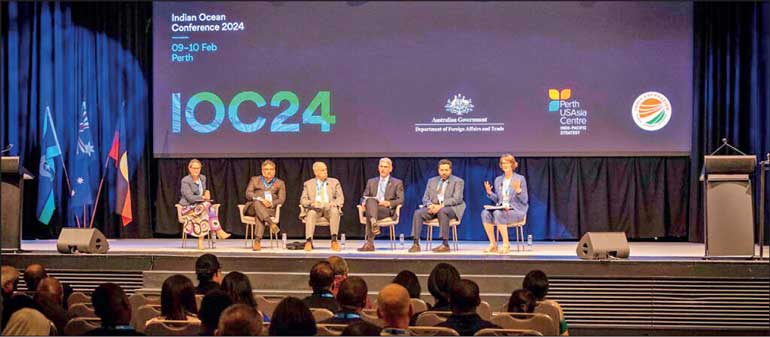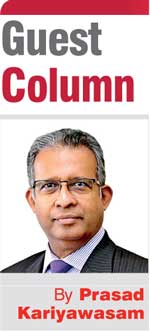Sunday Nov 23, 2025
Sunday Nov 23, 2025
Saturday, 2 March 2024 00:02 - - {{hitsCtrl.values.hits}}

International conferences like the Indian Ocean Conference that provide platforms for open and frank government and public interaction can engender wider public acceptance of critical path-breaking measures required for new initiatives towards sustainable development
 The 2030 Agenda for Sustainable Development adopted by the Member States of the UN in 2015 provides a shared blueprint for peace and prosperity for the people and the planet, in the present and into the future.
The 2030 Agenda for Sustainable Development adopted by the Member States of the UN in 2015 provides a shared blueprint for peace and prosperity for the people and the planet, in the present and into the future.
The 17 SDGs were identified to be achieved by 2030 to improve health and education, reduce inequality, and spur economic growth while tackling climate change and working to preserve our oceans and forests. This was an excellent program of action that would ensure sustainable development worldwide if fully implemented.
However, when one observes the progress made on each of the 17 goals agreed by the UN member States, it is now obvious that the countries in the world including those from the Indian Ocean region, have been tardy, and are far behind the speed required to achieve the SDG targets by 2030. Globally, only 15% of the targets are on track. 48% are moderately or severely off-track, and 37% are in stagnation or regression.
Countries in the region must endeavour to evolve a security architecture, first among like-minded states, with measures that can promote strategic harmony among key countries in the region. Such an architecture must especially focus on sustaining and expanding the protection of sea-based links, in particular undersea cable networks and freedom of navigation along major sea lanes crisscrossing the region. This is critical in today’s world to sustain supply chains and technological connectivity essential for human well-being and business
In the circumstances, it is obvious that the world and our region require not only to redouble efforts to achieve the agreed 17 SDGs but think of new ideas to inspire governments and mobilise people for achieving sustainable development through alternative means. Renowned historic civilisational achievements of the Indian Ocean region provide sufficient examples and guidance in this regard.
The Indian Ocean, since time immemorial, has not existed as an isolated ocean. It has been an ocean region connected with other regions far beyond – the Indo-Pacific, or Indo-Asia-Pacific on the Eastern side and Levant on the Western side, among others.
It has now come to light, following research, that the Indian subcontinent, during the Middle Ages and for nearly a thousand years, enjoyed 35% of the world’s GDP as compared to less than 5% today. The relative prosperity of the Indian Ocean region in ancient times was a result of connections with the rest of the world through land and sea. There was no air connectivity at that time. Examination of how international trade relations and people-to-people contact were carried out during that era gives an idea as to what needs to be done by countries in the Indian Ocean region now, for engendering sustainable development in this modern era as well.
In historic times, until the advent of the colonial era, especially when the region was thriving as an economic powerhouse of the world for a thousand years, no kingdom, entity, or principality had hard borders between them. Goods and services and people, including wise sages, crossed borders quite liberally seeking and exchanging ideas, and looking for opportunities for work, for trade, and on pilgrimage. The region enjoyed relative prosperity on the world stage during that time. However, as a result of the region coming under colonial rule, since the 16th century onwards, and in particular, as a result of adopting the Westphalian model of nation-states, by the 20th century, borders became gradually harder. This affected freer trade and the movement of people across borders.
Get back to historical tradition of softer borders
Without a doubt, among other reasons, this hardening of borders too would have contributed to the rapid and relative decline of the region’s economy. Hence, it can be surmised that if the region can get back to its historical tradition of softer borders where goods and services, and skilled personnel can transit with ease like in ancient times when our region was prospering, then that process has the potential to kick start economic development that encompasses the region in a sustainable manner. Softer borders can create even more efficient supply chains, linking production, trade, consumer and transit centres. It allows countries to quickly and nimbly adjust for any ongoing local or global changes, maintaining national and regional competitive edge.
And adding all these, to the soft border engendered ease of exchange of skills, raw materials and human resources can beget sustainable development across the region. Nevertheless, given the nature of inequalities and asymmetries that exist within and across the region, special and differential treatment will still need to be employed to safeguard vulnerable communities and smaller economies. However such needs and its attending regulations and standards will fade away when economic integration gradually delivers prosperity to all corners.
In this regard, it must be reckoned that the softening of borders should be underpinned by a robust security architecture that spans across the Indo-Pacific since soft borders and sustainable development can only survive in an atmosphere of sustained peace and stability across the region.
For this purpose, countries in the region must endeavour to evolve a security architecture, first among like-minded states, with measures that can promote strategic harmony among key countries in the region. Such an architecture must especially focus on sustaining and expanding the protection of sea-based links, in particular undersea cable networks and freedom of navigation along major sea lanes crisscrossing the region. This is critical in today’s world to sustain supply chains and technological connectivity essential for human well-being and business.
Robust human-security-based economic and social architecture
This can be complemented by a robust human-security-based economic and social architecture that is open, transparent, and accountable which can immensely contribute towards investor confidence essential for sustainable development. All these must have provisions that can subsequently expand and be embraced by other countries in the region and beyond, agreeing with the basic principles of the system to promote common prosperity.
Moreover, in the same spirit, countries in the region can nurture centres of excellence and hubs of human activity like industrial and agriculture production, trade, transit centres like ports – both wet and dry, and education and skill development. Such centres must not only connect efficiently with others within and outside the region but facilitate among them, the exchange of human resources as liberally as possible. Such a system of centres and hubs that span across the region, must not be exclusively single country enterprises, but multinational centres to enable providing goods and services at competitive cost, in a complementary and sustainable manner, thus engendering sustainable development in the region and beyond. Creating softer borders and appropriate security architecture in the region must not be subject to the success of the other. It must be a simultaneous effort, feeding on the success of the other and taking into account local conditions and compulsions for exemptions where necessary.
In our region, which at present is in a strategic flux if not competition, the forgoing views may seem like a fantasy. But we need to observe the EU – the region that gave rise to two world wars. The region is now well integrated, bringing human security and sustainable development to people living in the EU geographical space. In fact, as a result, there is a clamour among people living in vulnerable regions to enter the EU space even by illegal means.
Though creating political, security, and trade architecture, for achieving sustainable development is by and large the responsibility of experts and political leaders, to succeed sustainably, public trust and acceptance are essential. The voice of the people is paramount since it’s the ultimate key contributor to engendering sustainable development. And, international conferences like the Indian Ocean Conference that provide platforms for open and frank government and public interaction can engender wider public acceptance of critical path-breaking measures required for new initiatives towards sustainable development.
(The writer is former Foreign Secretary, Ambassador to the USA, High Commissioner to India, Ambassador/PR to the UN in Geneva and New York, and presently member of the UN Committee on Migrant Workers.)